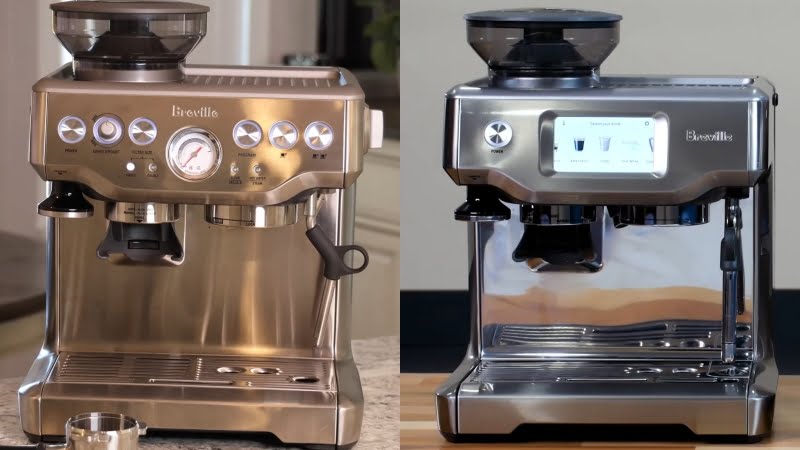Between the Barista Express Vs Barista Touch, I decided to take a leap, going for the Barista Touch over the Express version. It’s because the Touch is customizable, intuitive, and easier to use for beginners than its rival.
The Barista Touch provides the convenience of a near super-automatic while letting you have some control over the grind and tamp of the coffee. What impressed me when purchasing the machine is its automatic steam wand that can produce a nice and velvety milk texture. Moreover, this auto-milk steam wand can be used manually if you want to control your milk texture in your own way. The machine also has 5 coffee drink presets and 8 extra profiles to be personalized and saved.
The Barista Express comes with a more affordable price tag but takes you more time and effort to get decent brews, especially when you have no experience. Its automation is limited, including auto grind and auto dose. It does not have a touchscreen for easy customization, but it features a pressure gauge to assist you in producing good espresso shots. Thus, if you are looking for a machine to get to know every step of the process to make an espresso drink, the Barista Express is a nice option.
Barista Express Vs Barista Touch: Comparison Chart




Last update on 2025-04-14 / Affiliate links / Images from Amazon Product Advertising API
Barista Express Vs Barista Touch: Differences
The Barista Touch wins 3-0 against the Breville Barista Express. For me, the Barista Touch is a nice upgraded version of the Barista Express, providing more automation for convenience while allowing hands-on experiences for coffee enthusiasts to practice.
Coffee flavor & Brewing system
Winner: Breville Barista Touch
Grinder & Tamper
Both appliances feature a nice built-in grinder with a hardened stainless steel conical burr. However, the Barista Touch has more grind size settings than the Express, allowing me to dial in the coffee ground fineness more precisely. Specifically, the number of grind settings of the Barista Touch is 30, and of the Barista Express is 16.
With the Barista Touch, I prefer my grind setting at 17, and the espresso flow is about 30 seconds with a nice, pleasant honey color and a full-bodied flavor. And for the Barista Express, my preference grind size is 5 for the balanced and rich crema shot.
With these two machines, you have to do the manual tamp, and their included tamper is nice. I can do a proper tamp with their tamper, so I believe you don’t need to buy the new one. Note that you should keep your hand at a 90-degree angle when tamping down the coffee ground so that the coffee can be uniformly packed.
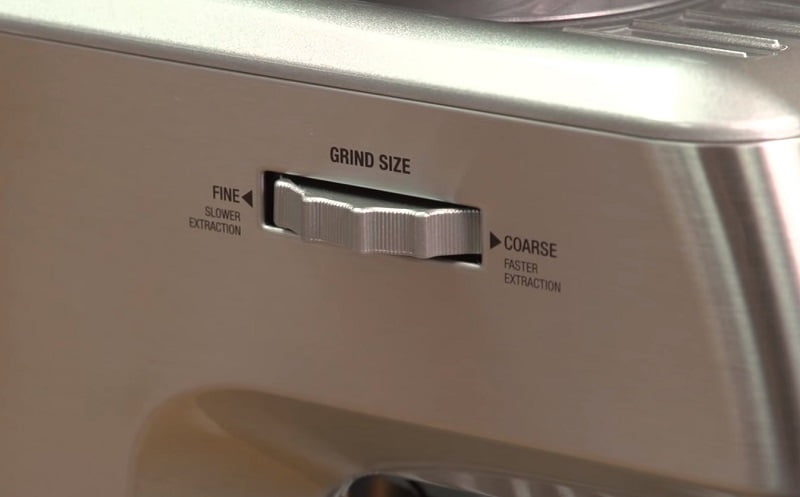
Heating system
The Barista Touch and Barista Express use a single-boiler system, so they cannot brew and steam at the same time. In addition, they feature the PID element to control the water temperature so that the temperature consistency can be well maintained throughout the brewing process.
The difference is in their key heating element. The Barista Touch has the ThermoJet heating technology, enabling a quick heat-up time of about 3 seconds. Meanwhile, the Barista Express features the conventional thermocoil heating element. The heat-up time of the Barista Express is a bit longer, taking about 1-3 mins to reach the optimal temperature.
Brewing performance
For me, both machines can produce robust and full-bodied espresso shots with a nice crema layer. However, again, making good espresso cups is easier using the Barista Touch than Barista Express owing to the former’s automation.
The Barista Touch and Barista Express offer automatic coffee dosing based on the selected volume, which is convenient but exhibits inconsistency. The auto dose often gives about 0.5-1.5 grams more than the amount I want, leading to inconsistency in espresso flavors. Fortunately, I can do the manual dosing with these two machines so that I can precisely weigh the amount of coffee ground to get the best results.
Both of the machines feature the pre-infusion mechanism and 15-bar pump pressure for optimal extraction, delivering a full-bodied espresso shot of 9-ish bar. They allow me to change the brewing time (manual override) to get the coffee volume and strength at the way I want it to be.
I can also adjust the brewing temperature, which I really appreciate. Specifically, I can change the brewing temperature by ±4oF (2oF increments at a time) on the Barista Express. Meanwhile, in the settings section of the Barista Touch, the brew temperature can be increased or decreased by 4 levels from the ideal point (factory setting).
I found that the default brew temperature delivered decent hot espresso cups every time. I took a test on the water hotness at the factory-setting brewing temperature of these machines. The result was in the range of 197-199oF, which was quite close to what the brands described.
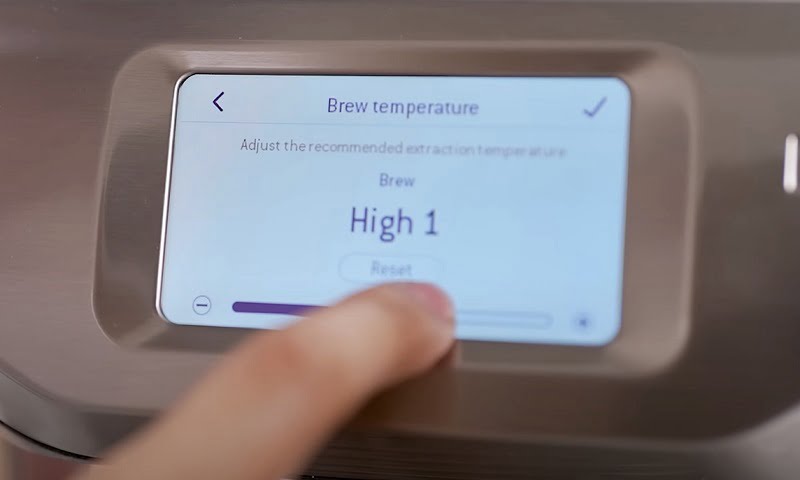
Design & Convenience
Winner: Breville Barista Touch
Capacity & Dimension
The dimensions between the Barista Touch and Barista Express are quite similar to each other. With their 16-inch height and 13-inch depth, they will need more space on the counter and under the cupboard to accommodate them.
They also boast the same capacities of bean hopper (8 oz) and water reservoir (67 oz). Their water reservoir is positioned at the back of the machine, which is not really convenient for re-filling because I need to move the machine out quite often.
Drink programmability
When it comes to beverage options, the Barista Touch truly stands out for me. It presents 5 pre-programmed coffee drinks (Espresso, Americano, Latte, Flat White, Cappuccino, and Hot Milk), offering me the delightful convenience of crafting my favorite cup with just a simple touch. Moreover, the Barista Touch helps me reduce the daunting task of remembering every customized recipe by allowing me to save 8 personalized drinks. This feature also comes in handy in situations where you have frequent visits from friends and cousins.
On a different note, the Barista Express takes a divergent approach from its counterpart, lacking the ready-made drink presets akin to the Barista Touch. On this machine, my one-touch beverage repertoire is limited to single and double-shot espressos. Beyond that, I need to master and keep note of the recipes and techniques for creating superior espresso-based drinks.
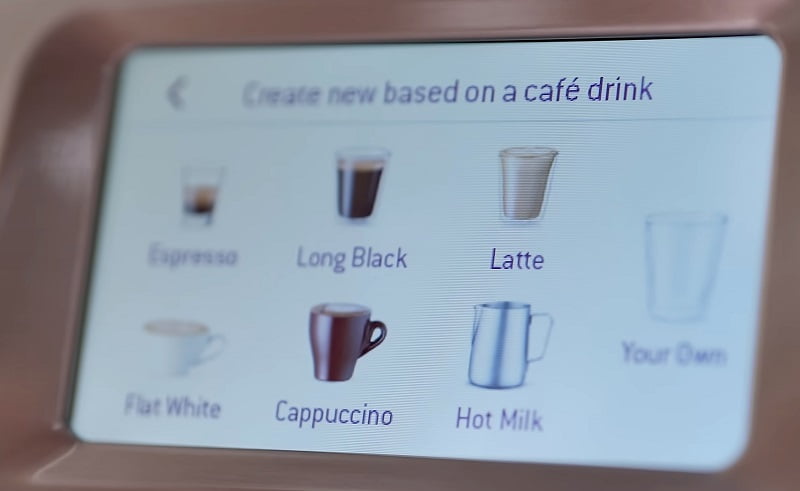
Interface & Hot water spout
Both the Barista Touch and Barista Express come equipped with their own separate hot water spouts, which I find very useful for making americano or pre-heating cups. However, the hot water spout on the Barista Express is not situated close to the group head like the one on Barista Touch. So, I need to take an extra step to move the cup after the espresso shot has been pulled when I want to make an americano.
Moreover, the two machines feature distinct interfaces and controls. The Barista Express boasts a pressure gauge and button controls, whereas the Barista Touch uses a touchscreen for every operation. The touchscreen of the Barista Touch offers convenience in terms of visual feedback. It enables easy interaction with the machine, providing a clear display of the adjustments made during the brewing and frothing processes. This visual aid simplifies the process of learning to pull a great shot.
However, a minor drawback of the touchscreen is its inability to display extraction pressure during the shot. In contrast, the pressure gauge on the Barista Express allows me to monitor the extraction pressure and determine whether it falls within the optimal range for the best shot. However, without the visual confirmation, I must make adjustments based on guesswork if the pressure deviates from the ideal range.
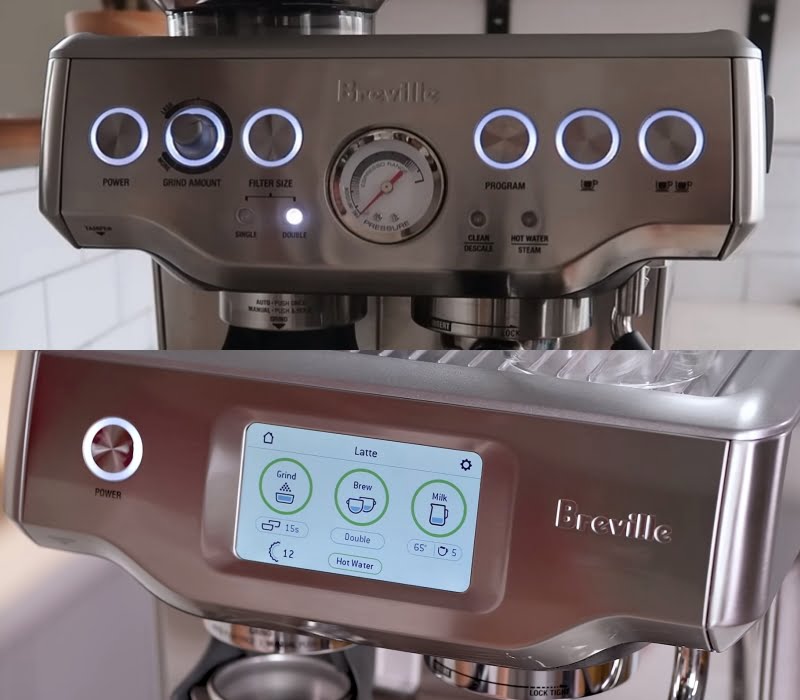
Milk system
Winner: Breville Barista Touch
I find the milk steam wand on the Breville Barista Touch to be more appealing than that on the Barista Express. What impressed me about the Barista Touch’s steam wand is its versatility in offering both automatic and manual milk frothing. Additionally, it grants users the freedom to adjust milk foam levels and temperature according to their personal preferences.
The MilQ automatic milk wand featured on the Barista Touch has proven to be remarkably user-friendly, producing good froth without a need to know the skills of texturing milk. The process is quite straightforward: put the milk in the jug, place the jug in alignment with the temperature sensor for precise control, put the milk wand in the jug, press to start the process, and let the machine do the rest.
Furthermore, the Barista Touch provides an option to switch to manual steaming mode so that I can have time to refine my frothing techniques. However, you still need to pre-purging the steam wand is necessary to achieve dry steam, preventing an unintended addition of excess water to the milk.
In contrast, the milk system of the Barista Express is entirely manual. It does not include options for adjusting milk temperature or froth levels. Consequently, acquiring the desired milk texture for various milk-based espresso drinks relies on mastering the skills of frothing and steaming. This aspect does demand an investment of time and effort, but for those dedicated to the craft of espresso-making, especially crafting lattes and cappuccinos, it is an enjoyable and rewarding journey.
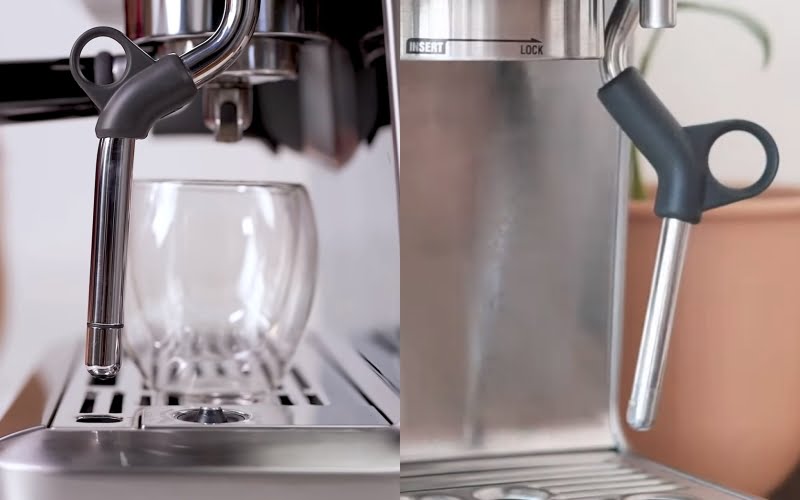
Cleaning & Maintenance
Tie!
As both the Barista Touch and Barista Express involve manual steps in making coffee specialties, there are messes and parts to clean regularly. After each brew, it’s necessary to empty and clean the portafilter, a process that often results in some spillage on the countertop. Moreover, its auto-purge steam wand has a tendency to cause water splashes, leading to a relatively quick filling of the drip tray. So, regular cleaning is essential, and a swift scrub with soap can prevent any unpleasant odors from developing.
Furthermore, both machines are equipped with alerts to signal when it’s time to initiate the descaling cycles. Carrying out the descaling procedures for both models is uncomplicated; all that’s required is to follow the step-by-step instructions provided in their instruction manuals.
Additionally, both machines include a water filter and water filter holder in their packages, although their utilization remains optional. From my personal standpoint, I would recommend making use of the water filter, as it effectively softens the water, reducing the need for descaling. Moreover, it’s advisable to replace the filter cartridge every 2-3 months to maintain optimal performance.
Quick Rundown Of Breville Barista Touch
- The Breville Barista Touch delivers third wave specialty coffee at home using the 4 keys formula and is part of the Barista Series that offers all in one espresso machines with integrated grinder to go from beans to espresso in under one minute
- DOSE CONTROL GRINDING: With a single touch, the integrated precision conical burr grinder with dose control delivers the right amount of coffee on demand, for maximum flavor
- OPTIMAL WATER PRESSURE: Low pressure pre-infusion gradually increases pressure at the start and helps ensure all the flavors are drawn out evenly during the extraction for a balanced tasting cup
- FASTER HEAT UP TIME: Innovative ThermoJet heating system achieves the optimum extraction temperature in 3 seconds
- PRECISE ESPRESSO EXTRACTION: Digital temperature control (PID) delivers water at precisely the right temperature, ensuring optimal espresso extraction
Last update on 2025-04-14 / Affiliate links / Images from Amazon Product Advertising API
Quick Rundown Of Breville Barista Express
- The Breville Barista Express delivers third wave specialty coffee at home using the 4 keys formula and is part of the Barista Series that offers all in one espresso machines with integrated grinder to go from beans to espresso in under one minute
- DOSE CONTROL GRINDING: Integrated precision conical burr grinder grinds on demand to deliver the right amount of freshly ground coffee directly into the portafilter for your preferred taste with any roast of bean
- OPTIMAL WATER PRESSURE: Low pressure pre-infusion gradually increases pressure at the start and helps ensure all the flavors are drawn out evenly during the extraction for a balanced tasting cup
- PRECISE ESPRESSO EXTRACTION: Digital temperature control (PID) delivers water at precisely the right temperature, ensuring optimal espresso extraction
- MANUAL MICROFOAM MILK TEXTURING: The powerful steam wand performance allows you to hand texture microfoam milk that enhances flavor and enables creation of latte art
Last update on 2025-04-14 / Affiliate links / Images from Amazon Product Advertising API
Product Video
Related Articles to Breville Barista Touch
- Breville Barista Touch vs Bambino Plus: The Ultimate Debate Of 2 Breville’s Espresso Machines
- Gaggia Anima Prestige Vs Breville Barista Touch: In-Depth Review and Detailed Comparison
- Jura E6 Vs Breville Barista Touch: A Battle Between a Semi-automatic Machine and A Superautomatic
- Breville Barista Touch vs Dual Boiler: One Is Clearly Better Than The Other!
- Barista Touch vs Jura E8: An Honest Comparison Of Two Mid-range Espresso Machines
- Breville Oracle Touch Vs Barista Touch: Is That A Big Update?
- Barista Touch Vs Oracle: Is It A Wise Investment?
- Breville Barista Touch vs Delonghi La Specialista: Is The Barista Touch Worth The Extra Investment?
- Breville Barista Touch Vs Philips 3200: Which One Is Your Best Choice?
- Breville Barista Touch Vs Barista Pro: Which Breville Fits You Best?
Related Articles to Breville Barista Express
- Breville Barista Express Vs Rancilio Silvia: How Are They Different?
- Breville Nespresso Creatista Plus Vs Barista Express – Which Machine Is Suitable For You?
- Saeco Incanto vs Breville Barista Express: Is Super-automatic Machines Always Better Than Semi-automatics?
- Gaggia Brera vs Breville Barista Express: Don’t Miss My Review On These 2 Affordable Entry Espresso Machines
- Gaggia Anima Vs Breville Barista Express: Battle Of Two Budget-Oriented Espresso Machines!
- Delonghi Magnifica S Smart vs Breville Barista Express: Comparison Of 2 Very Distinctive Espresso Makers
- An Honest Review Of Breville Barista Express vs Oscar 2: Brew Performance, Milk Frother, And More!
- Breville Barista Express vs Delonghi Magnifica XS: An Honest Review Of My Real Experience With These Machines
- Barista Express 870 vs 875: Is There Any Difference Between These Models? – Quick Comparison
- Delonghi Magnifica S vs Breville Barista Express: Which One Brews Tastier Coffee?
- Breville Duo Temp Pro vs Barista Express: Why you should go for the Barista Express
- Breville Oracle Touch Vs Barista Express: Competition Between 2 Top Breville Machines
- Breville Bambino Plus Vs Barista Express: 4 Hot Features You Need To Know
- Breville Dual Boiler Vs Barista Express: A Wonderful Comparision For You
- Breville Barista Express Vs Delonghi La Specialista: Detailed Comparison!
- Breville Barista Express Vs Barista Pro: A Detailed Side-By-Side Comparison
- Breville Barista Express Vs Philips 3200: A Hands-On Comparison
- Breville Creatista Plus Vs Barista Express: Don’t Miss This Incredible Comparison
- Breville Barista Express vs Infuser: A Battle Between 2 Great Espresso Machine
- Barista Express Vs Oracle: Which Breville Espresso Machine Is Best for You?
- Barista Express Vs La Specialista: A Hot Comparision You Should Not Miss
- Breville Barista Express Vs Gaggia Classic Pro: Which Is A More Suitable Purchase?
- Breville Barista Express vs Bambino: Battle Of the 2 Top Beginner Coffee Machines On the Market
- Breville Barista Express Vs Bambino Plus: Amazing Comparison You Should Read
- Nespresso Creatista Plus vs Breville Barista Express: What Is The Best Choice For Home Use?
- Breville Cafe Roma vs Barista Express: What Is the Best Espresso Machine?
Reference:
- Breville Barista Touch: https://www.breville.com/us/en/products/espresso/bes880.html
- Breville Barista Express: https://www.breville.com/us/en/products/espresso/bes870.html

I’m Floyd J. Alcock, an experienced barista with a deep love for coffee. I curate personalized coffee experiences, guiding customers through diverse flavor profiles and suggesting ideal brewing methods. My extensive knowledge of espresso machines enables me to recommend the best equipment to match specific needs and budgets. Sharing my expertise and passion with coffee enthusiasts brings immense satisfaction. I look forward to continuing my journey of coffee discovery with every customer I serve, fostering connections over a shared love for this magical beverage.
